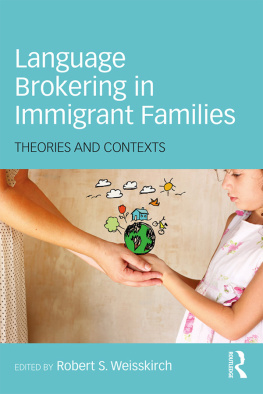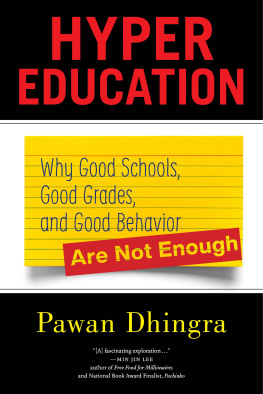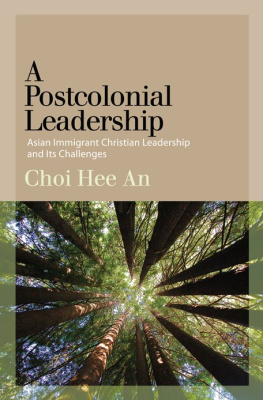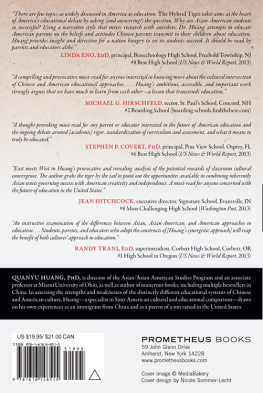NEW YORK UNIVERSITY PRESS
New York
www.nyupress.org
2018 by New York University
All rights reserved
References to Internet websites (URLs) were accurate at the time of writing. Neither the author nor New York University Press is responsible for URLs that may have expired or changed since the manuscript was prepared.
Library of Congress Cataloging-in-Publication Data
Names: Okazaki, Sumie, author. | Abelmann, Nancy, author.
Title: Korean American families in immigrant America : how teens and parents navigate race / Sumie Okazaki and Nancy Abelmann.
Description: New York : New York University Press, [2018] | Includes bibliographical references and index.
Identifiers: LCCN 2017060985 | ISBN 9781479804207 (cl : alk. paper) | ISBN 9781479836680 (pb : alk. paper)
Subjects: LCSH : Korean AmericansUnited States. | Korean AmericansFamily relationshipsCase studies. | TeenagersFamily relationshipsUnited StatesCase studies. | Children of immigrantsFamily relationshipsUnited StatesCase studies. | Korean AmericansInterviews. | United StatesRace relations.
Classification: LCC E 184. K 6 O 44 2018 | DDC 305.8957/073dc23
LC record available at https://lccn.loc.gov/2017060985
New York University Press books are printed on acid-free paper, and their binding materials are chosen for strength and durability. We strive to use environmentally responsible suppliers and materials to the greatest extent possible in publishing our books.
Manufactured in the United States of America
10 9 8 7 6 5 4 3 2 1
Also available as an ebook
Introduction
Eight years after we had first met her and her family as part of an ethnographic study of Korean American families, we checked in with Jenny Park, a bright young Korean American woman in her early twenties and a key informant in our study. We had met Jenny and her family when Jenny was just fourteen years old, and we kept in intermittent contact with her and her family in the ensuing years. We had known that after graduating from high school, Jenny had entered a prestigious conservatory for cello; and, as you will learn, we had thought that Jenny was on her way to becoming a professional musician, just as a well-honed family plan would have predicted. By that summer, however, Jenny had decided on a radical change in her career path. Having recently graduated from a renowned conservatory, she had garnered a coveted spot at a respected summer music festival and was truly enjoying it. But in our conversation, Jenny revealed that she had decided, come fall, that she would begin her exit from a musical career by moving back home and taking preveterinary science coursework at a local community college.
This was huge news. When we first began writing the chapter on Jenny and her family, it had been easy to settle on calling it A Music Strategy because that title so encapsulated her Korean-born mothers strategy for raising her American-born daughterand for that matter the seeming consensus of the entire family when it came to Jennys future. Yet, it was also true that even in our early encounters with Jenny, she had talked about someday wanting to become a veterinarian. Nancy was indeed a bit amazed during that check-in in 2012 when Jenny recalled a discussion with us from her teen years: Do you remember what I told you back then? About my wanting to become a veterinarian? When we learned of Jennys big change of plans, we could not help but wonder what Jenny now thought about her considerable (albeit impressive) musical detour toward her dream career. We were also curious about how and when Jenny had told her mother about this big decisionand most of all about how her mother had reacted.
We will save those details for a later chapter, but here we want to draw attention to the fact that Jenny seemed remarkably at peace with having engaged in long and arduous musical training that had taken her off-course from pursuing a career she had envisioned. At different points over the years, Jenny told us that she realized that music was the only career that her pianist mother could have imagined for Jenny. Not only that, it was the only career for Jenny that her mother could have facilitated with her own skills and know-how. Indeed, Jenny had told us several times during her teen years that she had thought of her music training as nearly inevitable. Yet, perhaps because as an adult she could now walk away from a music career despite an enviable resume, knowing that she possessed the personal fortitude to undertake rigorous training, Jenny let us know that there was no reason to harbor resentment toward her mother, who had steered her down this path. Furthermore, it was clear that her musical skill would always be a valuable asset as a source of personal enjoyment as well as supplementary income. This sort of retrospective narrative echoed the findings of a previous 20032004 campus study that we had conducted with Korean American emerging adults who were students at the University of Illinois at Urbana-Champaign in east central Illinois: namely, that Korean American emerging adults often sympathized with, and forgave, immigrant parents who could not help but parent them in a certain way (such as working long hours and being absent from the childrens daily lives, holding children to impossibly high standards, not behaving like their White friends parents, and so on). At that time, we were impressed by the disjuncture between what seemed like difficult childhoods and the young adults generous, forgiving reflections on family life and well-being. Indeed, that University of Illinois study spurred us to learn more about how Korean American teens and their parents navigate family life and visions of success in America.
***
This book is a result of a decade-long, mixed-method, longitudinal research collaboration between an anthropologist and a psychologist. In the early 2000s, weNancy Abelmann and Sumie Okazakiembarked on two successive studies of Korean American immigrant families: first with the college students on the flagship campus of the University of Illinois, mentioned above, and then with high-school-age teens and their parents in the greater Chicago metropolitan area (dubbed Chicagoland). The Chicagoland study was born of our shared intrigue with the apparent resilience of Korean American emerging adultsmany of whom we were teaching at the University of Illinoisand more generally, our curiosity about how immigrant Asian American families navigate the sometimes-tricky landscape of the late teen years and young adulthood. Our research collaboration was seeded in the spring of 2000, and what started as a collegial conversation about our respective work grew over a decade and a half into research projects and co-authored works as well as a close friendship.
Each of us brought our disciplinary lens and methods to this project. Until our collaboration, Sumie, a research psychologist whose expertise is in Asian American mental health, had largely employed quantitative methods. Nancy, a cultural anthropologist who specialized in the Koreas and Asian America, had used ethnographic methods in all of her previous work. We began with a mixed-method study on campus that combined a survey and interviews with Korean American and White American college students, then expanded the study into a mixed-method study of Korean American teens and parents. The Chicagoland study, which forms the basis of this book, included collecting survey responses from 205 Korean American teens and 101 Korean immigrant parents, a pool from which we recruited families in which both teens and parents were interested in taking part in the family ethnography portion of the study. In the end, we worked with five Korean American families who engaged with us intensively in the mid-2000s when the focal teens in the families were high school students, and then we followed them into young adulthood over the subsequent years. The ultimate aim was to explore the question embedded in the title of the book: How do Korean American teens and parents navigate immigrant America?









